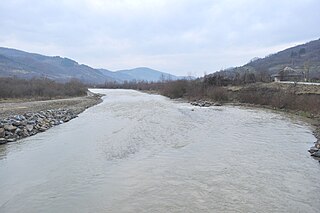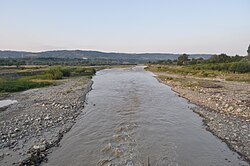
The Bistrița is a river in the Romanian regions of Maramureș, Bukovina and Moldavia. It is a right tributary of the river Siret. Near Bacău it flows into the Siret. Its source is in the Rodna Mountains, at the foot of the Gârgalău peak. It flows through the counties Bistrița-Năsăud, Suceava, Neamț and Bacău. The towns Vatra Dornei, Bicaz, Piatra Neamț, Roznov, Buhuși and Bacău lie along the Bistrița. The Bistrița is 283 km long, and its basin area is 7039 km².

The Olt is a river in Romania. It is 615 km (382 mi) long, and its basin area is 24,050 km2 (9,290 sq mi). It is the longest river flowing exclusively through Romania. Its source is in the Hășmaș Mountains of the eastern Carpathian Mountains, near Bălan, rising close to the headwaters of the Mureș River. It flows through the Romanian counties Harghita, Covasna, Brașov, Sibiu, Vâlcea and Olt. The river was known as Alutus or Aluta in Roman antiquity. Olt County and the historical province of Oltenia are named after the river.

The Moldova River is a river in Romania, in the historical region of Moldavia. It is a right tributary of the river Siret. The river rises from the Obcina Feredeu Mountains of Bukovina in Suceava County and joins the Siret near the city of Roman in Neamț County. The total length of the Moldova from its source to its confluence with the Siret is 213 km (132 mi). Its basin area is 4,299 km2 (1,660 sq mi).

Gălăciuc is a youth camp in Vrancea county, Romania, 3 km west from Tulnici village, 10 km east of Lepşa resort and 75 km west of Focşani at an altitude of 710 meters, near National Road 2D, in some of the most beautiful and picturesque surroundings in the Carpathians. Built in the 1970s in a very remote, mountainous region, it is the host of some national or international contests such as the Infoeducatie Applied Informatics Contests or The Omega Balkanic Physics contest. The camp can accommodate 390 persons, but the very poor conditions available on site have restricted its official maximum accommodation number to 250.

The Suceava is a river located in the north-east of Romania and western Ukraine. It is a right tributary of the river Siret.

The Someș, located in northwestern Romania, is a left tributary of the Tisza in Hungary. It has a length of 415 km (258 mi), of which 50 km are in Hungary. The Someș is the fifth river as length and debit in Romania. The hydrographic basin forms by the confluence at Mica, a commune about 4 km upstream of Dej, of Someșul Mare and Someșul Mic rivers. Someșul Mic originates in the Apuseni Mountains, and Someșul Mare springs from the Rodna Mountains.

The Buzău is a river in eastern Romania, tributary of the river Siret. Its total length is 302 km, and its drainage basin area is 5,264 km2. Its source is in the south-eastern Carpathian Mountains, east of Brașov. The Buzău flows through the Romanian counties Brașov, Covasna, Buzău and Brăila. It flows into the Siret close to its confluence with the Danube, west of Galați.

The Trotuș is a river in eastern Romania, a right tributary of the river Siret. It emerges from the Ciuc Mountains in the Eastern Carpathians and joins the Siret after passing through Comănești and Onești in Bacău County. The total length of the Trotuș from its source to its confluence with the Siret is 162 km (101 mi). Its basin area is 4,456 km2 (1,720 sq mi).

The Iza is a left tributary of the river Tisa in northern Romania. Its source is in the Rodna Mountains. It flows into the Tisa near the city Sighetu Marmației. It passes through the communes Săcel, Săliștea de Sus, Dragomirești, Bogdan Vodă, Șieu, Rozavlea, Strâmtura, Bârsana, Oncești, Vadu Izei, and Sighetu Marmației. Its drainage basin covers an area of 1,293 km2 (499 sq mi). Its length is 80 km (50 mi).

The Zăbala River is a right tributary of the river Putna in Romania. It starts at the confluence of headwaters Arișoaia and Zăbăluța. Several communes lie on its banks, starting with Nereju, Spulber, Paltin ,Naruja after it discharges into the Putna near Valea Sării.
The Șușița River is a right tributary of the river Siret in Romania. It discharges into the Siret in Doaga. It flows through the following towns and villages, from source to mouth: Rucăreni, Dragosloveni, Rotileștii Mari, Câmpuri, Gogoiu, Răcoasa, Varnița, Repedea, Panciu, Satu Nou, Tișița and Doaga.

The Râmnicul Sărat or Râmnicu Sărat is a right tributary of the river Siret in Romania. It discharges into the Siret in Nănești. The total length of the Râmnicul Sărat from its source to its confluence with the Siret is 137 km (85 mi). Its basin area is 1,063 km2 (410 sq mi). Its upper course, above the confluence with the Martin, is sometimes called Mălușel.

Tulgheș is a commune in Harghita County, Romania. It lies in eastern Transylvania. The commune is composed of four villages: Hagota (Hágótő), Pintic (Péntekpataka), Recea (Récefalva) and Tulgheș.

Water resources management in Syria is confronted with numerous challenges. First, all of the country's major rivers are shared with neighboring countries, and Syria depends to a large extent on the inflow of water from Turkey through the Euphrates and its tributaries. Second, high population growth and urbanisation increase the pressure on water resources, resulting in localized groundwater depletion and pollution, for example in the Ghouta near Damascus. Third, there is no legal framework for integrated water resources management. Finally, the institutions in charge of water resources management are weak, being both highly centralized and fragmented between sectors, and they often lack the power to enforce regulations. Water resources policies have been focused on the construction of dams, the development of irrigated agriculture and occasional interbasin transfers, such as a pipeline to supply drinking water to Aleppo from the Euphrates. There are 165 dams in Syria with a total storage capacity of 19.6 km³. Demand management through metering, higher tariffs, more efficient irrigation technologies and the reduction of non-revenue water in drinking water supply has received less emphasis than supply management. The government implements a large program for the construction of wastewater treatment plants including the use of reclaimed water for irrigation.

Putna County was a county in the Kingdom of Romania, in southern Moldavia. The county seat was Focșani.

The Putna-Vrancea Natural Park is a protected area situate in Romania, in administrative territory of Vrancea County.


























